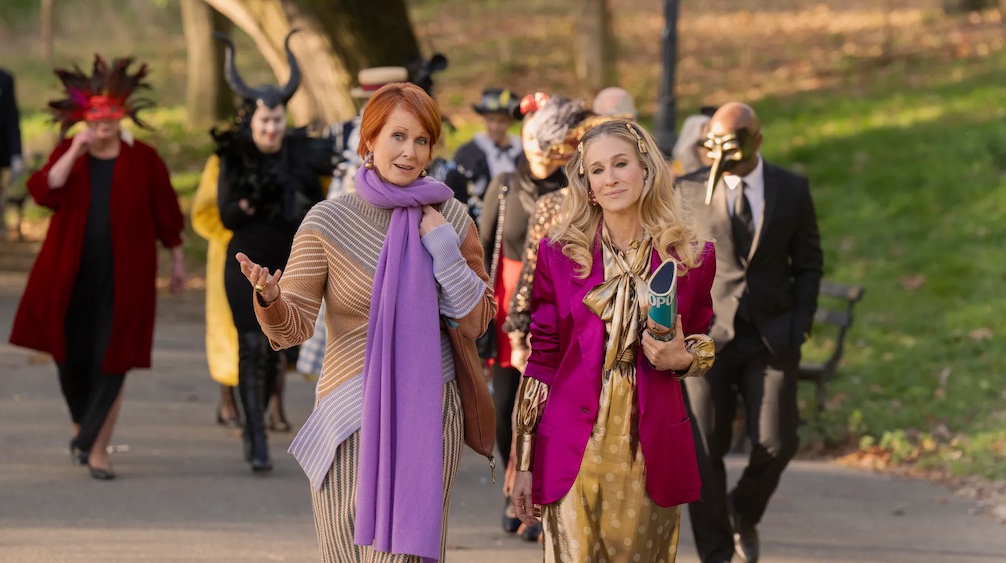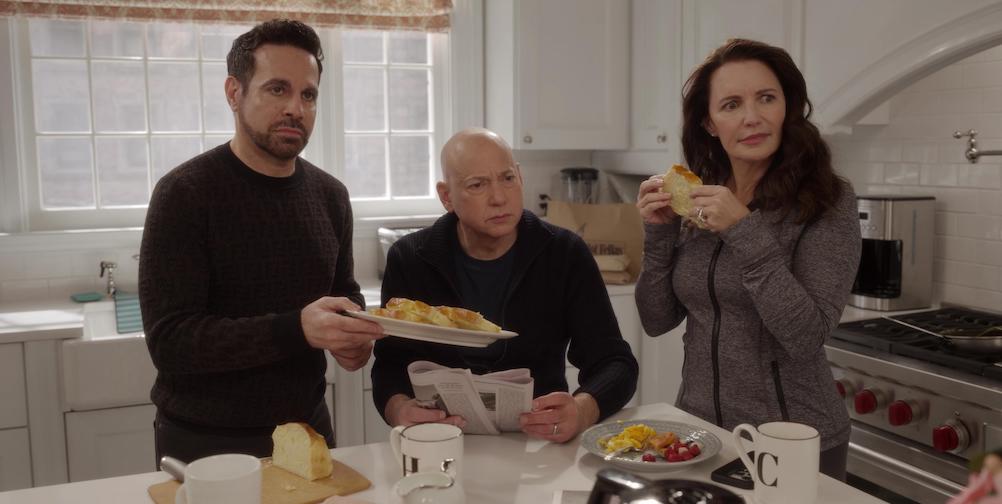
Music plays a large role when Emmy-award-nominated editor Allyson Johnson, ACE, approaches her editing choices. Her love of music began in college, where she was a music major studying clarinet performance at SUNY Purchase. She was also taking film classes and would often pay attention to the way sound was heard to define the action. In fact, she began her editing career gravitating toward several music-based projects, such as the documentary The Who’s Tommy: The Amazing Journey, which earned her an Emmy nomination, The Get Down, and Smash. Her feature editing projects include Monsoon Wedding, Vanity Fair, Amerlia, and New York I Love You for director Mira Nair, who once likened her editing style to having a sense of musical rhythm. As an associate editor, she cut for Summer Of Sam and He Got Game, where she assisted Spike Lee’s go-to editor, Barry Alexander Brown, whom she considers a mentor. Johnson’s other editing projects feature The Mosquito Coast, Hello Tomorrow!, Gossip Girl (Season 1), and Lucy & Desi: A Home Movie (NBC), to name a few.
For her most recent editing assignment, Johnson worked on several episodes for season 2 of And Just Like That (HBO), taking over for editor Michael Berenbaum. Johnson dove into the long-awaited episode, “February 14,” which features the reunion of Carrie Bradshaw (Sarah Jessica Parker) with Aidan Shaw (John Corbett). She also edited the episodes “Trick or Treat” and “Bomb Cyclone,” which was directed by Cynthia Nixon, who also stars as Miranda Hobbes; “A Hundred Years Ago,” and “There Goes The Neighborhood,” which feature Carrie and Aidan looking for possible new digs together.
Below The Line spoke with Allyson Johnson via Zoom video from her home in Jersey City. She discussed the nuances of editing the scenes between Carrie and Aidan so that they would be emotionally satisfying to the fans and viewers who have longed for their reunion since their breakup in Sex And The City. Johnson also talked about how her love of music influences her as an editor and how she fuses that talent with assembling scenes.

Below The Line: So how does a gal from Great Neck, Long Island become an Emmy-nominated editor?
Allyson Johnson: I was a musician in college. When I got out of college, I realized that although I love music, especially classical music, and I love playing, I didn’t want to do that for a living. My mother actually said, “Why don’t you go talk to our next-door neighbor, Lou Dorfsman,” who was an amazing guy at CBS. He was responsible for the eye and the CBS logo.
So I walked over there; he was sitting in his backyard, and I said, “Lou, I think I want to do something in television, but I don’t know anything about it.” And he was like, “Well, you know, it’s really hard.” And I said, “Well, I plan on working really hard.” So he gave me three names of people and said, “Just tell them you’ll do anything, including sweep the floors.”
One was Levine Pytka & Associates. They were commercial companies, and that’s actually the one where I ended up getting a job as a receptionist because, in those days, women started as receptionists and men started as PAs, right? So I had to take that.
BTL: What was the first job like for you?
Johnson: I was a terrible, terrible receptionist. Luckily, I only had to do it for six months, and a job opened up at ARTS (Alpha Repertory Television Service), which is now A+E Networks. But in those days, it was just starting out with cable television. It was three hours a night with fabulous classical music, ballet, and modern dance. It was a total of three hours of art every night. They had an opening in the promo unit, so I took the job, working day and night because cable television had no unions, and we literally worked 17 hours a day. Because it was a promo unit, I ended up doing everything. So I was the PA, and the people that I was working for were the producers who were writing, producing, and editing.There, I realized that editing was really what I enjoyed doing. So I edited in promos for a while, and then I really wanted to do long form.
BTL: How did you make the move into editing features?
Johnson: I really wanted to be in features, but it was impossible to move. I worked on some documentaries. I worked for Bill Moyers, which was an amazing experience as an assistant editor, and then moved into editing there and into documentaries through that. Moving from documentaries to features was impossible, but I did a documentary with director Barry Alexander Brown, who’s Spike Lee’s editor. That was the Tommy documentary.
After I finished that, I said to Barry, “I just want to get into features. Can you just hire me as your assistant?” He said, “Well, you’re an editor.” And I said, “Yes, I’m an editor, but it’s not going to hurt me to be an assistant, and that’s the only way I can break into features.” So he called me a few weeks later for He Got Game as an apprentice. I had to work my way up because it’s a union. And I was like, “Fantastic!”
BTL: In many ways Barry Alexander Brown gave you your big break.
Johnson: He’s really my mentor. He’s just an amazing guy. Taught me so much. He said you’d be an apprentice, but you’d really be cutting. In those days, they were cutting on film, and I had never touched film. So that was a real experience, cutting my first piece and splicing. I made some mistakes. The only way to learn is to make big mistakes. A chunk of the movie was like, over here! Because I was a musician, I was so sound-oriented that I was cutting one frame, then another frame, another frame, and nobody bothered to tell me that there’s no way to figure out where the sound is unless you write the numbers on every single frame, because there is a stamp every so often. So there I was, wanting to put things back. I looked in the bin, and there were all these tiny trims! So that was my big mistake.
BTL: It’s interesting that your ear went to the music, because music plays a really huge role in how you edit, doesn’t it?
Johnson: Oh yeah, definitely. I used to think it was just when I was cutting things like music pieces like Smash or The Get Down that were so heavily music-oriented that you had to be able to cut music, have a good ear, and all of that. But I realize that when you cut a scene, it’s not just dialogue; it’s all about the sounds. So you have dialogue here, and then if you have a space with nothing, there’s no visual happening; you have to fill it with some sort of sound.
For me, every scene basically has something happening all the time, whether it’s a visual or a sound. It could be music, a sound effect, or dialogue. It could be someone raising their hand. It’s just something that keeps the viewer going and keeps you interested. Of course, there are obviously moments where you don’t want anything, and that’s a whole different thing. It’s very important to have a balance between the sound and the picture.
BTL: No pun intended, but you’re really tuning into the sound when you edit.
Johnson: Oh, yeah, and because of my background, I tend to do a lot of the music editing on my own to begin with because I find I’m cutting and recutting scenes, and by the time I get things back from the music editor, I’ve already recut them, so then I have to cut them again anyway. So sometimes I save that for when things have to be finessed, the way only a music editor can do that. They have a much more tuned ear to the things that they can do, and they have a huge library and equipment that can cut fractions of a frame, and I don’t.
I tend to work a lot with the music first by myself. At the same time, I tend to not add music to a scene until I’m really happy with it because I find music can trick you into thinking something’s working. I find that a lot of people, if a scene’s not working, want to add music immediately. My thing is always to wait. If you want to put music on this scene, it means something’s not right, and we have to figure out what it is. Although I come from a musical background, I also find that I don’t like putting music on everything. I like really holding back. So when we put music on it, it really means something.
BTL: In editing And Just Like That, you didn’t come on until episode 205. What happened to the beginning?
Johnson: Michael Berenbaum, who’s been on Sex in the City since the very, very beginning and has worked with [creator] Michael Patrick King for many, many years, was directing the first few episodes, so Michael ended up cutting them. It was interesting because even though Michael had the first four and I had the next five, they ended up doing a lot of the work on the later episodes before working on mine because Michael had directed them. He kind of wanted to keep going in that vein.
BTL: So you got the opportunity to edit the long-awaited episode in this series, “February 14,” when Aidan and Carrie reunite which was viscerally unbelievable to watch.
Johnson: We all love Aidan. We’re so excited that they’re back. It’s funny because we got gifts for wrapping, and so I walk around with my And Just Like That bag, and I literally had people stop me in the subway to ask if Aidan was coming back, and I was like, “You know I can’t tell you that!” I never really experienced that before. Like all the other fans, I adore Aidan too, so it was kind of like, Oh my God, I really have to make this work.
Michael Patrick King had this idea about how he wanted him to kind of appear out of nowhere. He basically just wanted Carrie to come out, and she had all this anticipation, and then all of a sudden he appeared like magic. That was the big thing—that he appeared like magic. He always does things for a reason, and he has something set in his mind. He’s always there with the director, telling them what he thinks and how he wants it. I hope it came across the way we meant it to. It’s kind of hard to know because we’re so close to it.
BTL: It definitely worked. I got a little teary-eyed watching it. What was involved with the editing?
Johnson: It was a very short scene. When things are shot, you don’t necessarily have all the looks that you want from the characters, and in a moment like that, you really want to expand it a little bit. You don’t just want it to be one, two, three, and it’s over, so you want the back and forth between them because when they turn around and they look at each other, you want that moment. It’s funny because, in a moment like that, you never have enough. No matter how much they give you, you don’t have enough of it. You always want it; can we just get a little more of the look? No, you can’t, because they blink their eyes.
I mean, silly things ruin it—a blink of an eye, somebody turning their head the wrong way, you know? If the actor just happens to be there and you’re like, Ah, that’s the look we need, so you grab it from that spot. I mean, every frame of footage is really, really important. For that, it was a lot of just getting the right looks. How were they looking at each other? Is the turn too quick? Is it not quick enough? Things like that.

BTL: Was there supposed to be music in that scene?
Johnson: That was a tough one because we worked on the music for a long time, trying to get the right music for when she walks up to the restaurant and then when she comes out of the restaurant and the music in the restaurant. It was not an easy musical moment. I don’t think I was in the final mix for that one. I know that up until the last minute, they were actually changing some of the cues. They had some background music in the restaurant. You didn’t want something that was too sappy. You don’t want something that is going to give it away before it happens.
BTL: Another episode you edited was “Bomb Cyclone” which Cynthia Nixon directed. What was it like working with her?
Johnson: It was great because she knows the characters so well and all the people. She came really prepared. Sometimes when you work with actors who are directing, it’s only about the acting, but she was able to step out of that and actually look at the scene as a whole, not just at what this one actor was doing or even when she was acting in it. She did a terrific job.
BTL: What were some of her editing pointers?
Johnson: The end scene where her husband walks in and she’s there folding the laundry and everything—that was a tough one. We worked on that for a really long time, and it was all about kind of building it because it couldn’t start too tense and too crazy. But at the same time, you had to build to this crescendo, and then Cynthia falls apart at the end of it. It was a lot of trying to get exactly the right performances from both [Cynthia and David Eigenberg]. Sometimes, it meant just a few words from one take and a few words from another take. Then, of course, you have the silly things that editors have to deal with, where he’s holding a coffee cup in one take and not in the other take and really wants to use that, but there’s no way to use it because it just looks ridiculous, you know?
BTL: How do you work around continuity gaffes?
Johnson: It happens a lot, but there are also ways around it. There are certain things you just can’t unsee. I mean, it was really obvious that he was holding the coffee cup, and then he wasn’t magically. But there are other things where, and I find this a lot with new directors, they get almost too bogged down in the continuity. I just say if someone’s worried about that one thing about the shoulder being a little higher in this and then you flip around it, we’re doing something really wrong in the actual editing because the audience shouldn’t be concentrating on things like that.
Of course, I have to deal with continuity, and it’s an important thing. It kind of frustrates me when you have people who say that’s all they think about. They point it out: “Did you see the guy’s cigar was this long, and then it was all of a sudden this long?” And it’s like, “Okay, but how was the scene? Was it a good scene? Did it work?” Sometimes you just have to go with the best performance, and you have to give that up. Otherwise, you have less of a scene but great continuity.
BTL: What was your biggest challenge in editing the episode “There Goes The Neighborhood”?
Johnson: In this episode, Carrie and Aidan are talking about moving to a new place. There was a great scene where she brought Aidan to the new place to take a look at it, and it’s got really high ceilings. The way (director) Julie Rottenberg shot it, it was almost like them taking their marriage vows. It was terrific. So when I cut it, I was kind of cutting it as if the audience were really watching someone get married. It just felt like that to me. It was great to be able to get them there in that episode because there was a lot of tenseness because they were both so worried that things wouldn’t work out. But they were obviously both so in love; you had to kind of keep that in mind throughout the whole episode, not to drop either one of those things because it was a theme throughout.
BTL: At the end of the day, what is the most rewarding aspect of doing your job, would you say?
Johnson: Just coming up with a scene that actually works. I used to have problems with scenes where I had to work around silly continuity or actors forgetting their lines. That used to bother me, and now it’s more of a challenge for me. You realize that you’re never going to get something that’s perfect. The best part of editing is being able to make the most of what you get. In a narrative, when the actor has brought something completely different to the table and you adjust it, a lot of times it makes it much better.
And Just Like That can be streamed via Max (formerly HBO Max).





